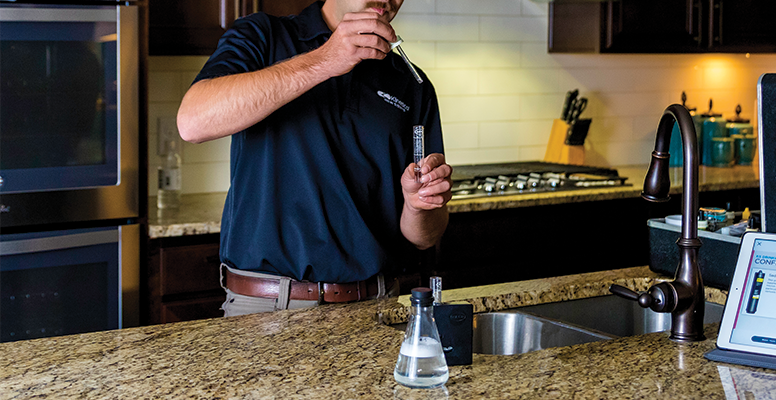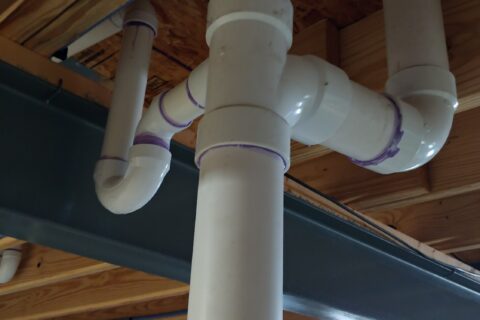Whole-House Water Testing: Key Parameters You Need to Check
Key Takeaways
-
Whole-house water testing provides a comprehensive look at water quality from all sources in your home. This not only protects you, but it helps identify what contaminants you may have.
-
Regular whole-house testing is important for municipal and private water supplies alike since even the best treatment systems can’t remove everything.
-
Key parameters to test for include pH, water hardness, microbial contaminants, heavy metals, chlorine, VOCs, and total dissolved solids. These checks are crucial in tailoring the most effective and efficient water treatment solutions.
-
Select at-home water test kits that provide rapid, easy-to-read results. If you require a deeper level of analysis, plan to hire experts, depending on your needs and budget.
-
Understand what your test results mean, how they compare to EPA standards, where the most significant risks lie, and what water treatment steps to take.
-
Regular water testing protects your family’s health, plumbing and appliances, and avoids costly problems down the line while giving you peace of mind that your water is always safe.
Whole-house water testing ensures the water quality in your home meets safety and health standards. Testing focuses on identifying common contaminants like bacteria, lead, nitrates, and chlorine levels.
Evaluating water hardness helps assess mineral buildup risks, while pH levels indicate acidity or alkalinity affecting plumbing and appliances. It’s essential to check for volatile organic compounds (VOCs) and pesticides, especially in areas relying on private wells or agricultural zones.
Understanding your water’s composition supports informed decisions for filtration systems or treatments. Regular testing provides peace of mind and safeguards your household’s overall health.
Whether city-supplied or well-sourced, thorough analysis creates a foundation for clean and reliable water throughout your home.
What Is Whole-House Water Testing
Whole-house water testing is an in-depth examination of every source of water in a home. It’s a look at drinking water quality. It’s important to know about the safety of water in your home that you bathe, clean, and cook with.
This testing looks at the water coming out of each faucet. It protects against problems falling through the cracks. This step is very important in identifying dangerous contaminants. These contaminants can be harmful to your health, as well as to your plumbing system.
For one thing, it can’t identify the presence of certain substances like chlorine or total dissolved solids (TDS). All of these factors can affect the taste of water, irritate skin, or diminish appliance efficiency. In addition, it reveals alarming threats like lead, arsenic, bacteria, and hydrogen sulfide.
These tips can be useful for both municipal water users and private well owners. Regular testing is crucial, particularly in the case of private wells, where annual checks should be required. Some results, such as hardness levels, may be available in minutes, but more complex analyses may take several days to process.
It’s these tests that challenge us to discover the best possible outcomes. For the latter, we can install reverse osmosis systems and other treatments rapidly, sometimes within a few days. With labs like Culligan managing tens of thousands of samples per year, this is a reliable and customer-friendly service.
Why Whole-House Water Testing Matters
The Environmental Protection Agency (EPA) is responsible for establishing important water quality standards, ensuring that safe drinking water reaches every corner of the country. These regulations aim to keep our drinking water free from dangerous contaminants, such as lead, arsenic, and nitrates, which are critical water quality indicators for the health of our communities.
The EPA abdicates responsibility by relying on municipal treatment systems to satisfy these standards. While these systems are effective at removing many pollutants, they are not foolproof. Outdated infrastructure or specific areas of contamination can allow harmful substances, like pesticides or heavy metals, to pass through, highlighting the need for a reliable home water test kit.
This gap makes personal water testing so vital, as it provides homeowners with a more accurate reflection of their water safety and quality. Conducting an extended well water test before selecting a purification system can save money both upfront and in the long run.
If you’re unaware of the specific contaminants in your water, you might waste time and money on filters that don’t address the right issues. For instance, installing a water softener without first utilizing a comprehensive water testing kit to check hardness levels could lead to unnecessary expenses. Regular testing allows you to identify the solutions needed to effectively address water quality issues, saving you from costly mistakes.
Aside from money saved, regular water testing can keep your home healthy and safe. This is crucial if your home contains particularly sensitive populations, like children or the elderly. By staying one step ahead, you can act on changes in water quality before they pose a risk to your household.
Key Parameters to Check
When testing your home’s water quality, focus on these key parameters for a comprehensive understanding: pH levels, hardness, contaminants, microbial presence, heavy metals, chlorine, volatile organic compounds (VOCs), and total dissolved solids (TDS). Each parameter provides important information on water safety and aids in customizing suitable treatment solutions.
Giving priority to these checks means smarter, more equitable management of our water resources today and years from now.
1. Test for pH Levels
PH is a measure of how acidic or basic the water is, with a recommended drinking water standard of between 6.5 and 8.5. This range strikes a good balance between safety and taste and protects plumbing from corrosion.
Water with very high or very low pH can either corrode pipes or lead to mineral buildup. Testing kits are readily available and can help you get accurate readings, and if your water is found to be outside this range, calibrating is easy.
For example, pH levels lower than 6.5 can cause corrosion, whereas levels higher than 8.5 can cause scaling.
2. Check for Hardness
Hard water is caused by high concentrations of calcium and magnesium, usually expressed in grains per gallon (gpg). Soft water is 0-3 gpg, while anything above 8 gpg means you have hard water.
Excess hardness leads to scale formation, damaging or destroying appliances and fixtures. Test strips make measuring easy, and a water softener is recommended if hardness is too high.
Levels higher than 8 gpg can corrode plumbing or even wear out appliances.
3. Assess for Contaminants
Testing for heavy metals, pesticides, and bacterial contaminants significantly lowers the risk of negative health effects. Even concentrations higher than 0.05ppm manganese may cause staining of your fixtures.
At the same time, high copper levels above 1.3 mg/L can point to plumbing corrosion and result in copper poisoning. For private wells, which are more likely to be polluted, use multi-contaminant kits to test for a range of possible contaminants.
4. Evaluate Microbial Presence
Microbial testing helps us locate harmful bacteria such as E. Coli that can cause severe illness or even death. Routine monitoring is extremely important for untreated sources or well water.
Water test kits you can trust provide accurate, easy-to-read results that give you confidence about the safety of your water.
5. Measure Heavy Metals
Heavy metal tests often look for elements such as lead, arsenic, and mercury. Homes built before the 1980s with corroded pipes are at higher risk.
Health-based standards exist, such as lead levels over 15 ppb being dangerous, and copper levels over 1.3 mg/L being unsafe. Due to the serious health hazards heavy metals can cause, professional lab tests are strongly advised in the case of suspected contamination.
6. Detect Chlorine and Chloramines
Chlorine is an important part of disinfection, but too much of it can cause taste and health issues. Test kits are useful for measuring chlorine and chloramine levels.
Filtration systems should be deployed in communities with levels above 4 mg/L to ensure they are drinking safe water.
7. Identify Volatile Organic Compounds (VOCs)
VOCs come from industrial chemicals or household products that wash into water. Risks of long-term exposure include respiratory issues.
Specialized VOC test kits are capable of detecting these harmful compounds, and expedited remediation is critical to preventing their long-term health effects.
8. Analyze Total Dissolved Solids (TDS)
TDS is a general measure of all dissolved solids, with more than 500 ppm considered unacceptable water quality. Although high TDS values make water taste salty, metallic, or bitter, they can indicate specific contaminants.
A TDS meter is good for quick, general measurements, and effective filtration systems can enhance water quality, if required.

Tools and Methods for Testing
Learning about the tools and methods of using a DIY well water test kit will better equip you to choose the right approach for monitoring and maintaining your water quality with effective water quality testing.
Use Home Water Testing Kits
Home water testing kits provide an easy and affordable option for testing water. These kits usually check for common contaminants such as lead, chlorine, nitrates, and bacteria. Most of these kits test for pH, hardness, and other factors.
For instance, you can find kits that utilize test strips or drop-based systems that produce easily interpretable, color-coded results. Look for reputable brands with high quality review scores to make sure they are reliable.
Regular testing is just as important. Testing with these kits every few months allows you to monitor fluctuations in water quality over time. If you see an unexpected change in results, it could indicate a need for more investigation or action.
Read the instructions that come with the kit and don’t make assumptions or mistakes.
Hire Professional Testing Services
For more in-depth evaluations, professional services are best. Specialists use sophisticated technology to locate any potential hazards. This includes hidden hazards such as pesticides and heavy metals that at-home test kits may overlook.
Accredited laboratories guarantee that the data is accurate, which is why this is a wise investment for solving complicated problems. Though this option is always the more costly one, it offers reassurance.
These experts can provide customized advice on best treatment options to address the specific problems with your water. For homes with private wells or older homes, it is a best practice to schedule a professional test every one to two years.
Collect Water Samples Properly
Correct sampling is important for getting accurate results. Start by avoiding contamination in the first place by using clean, BPA-free containers. If you’re using a home kit or testing method, follow the instructions provided with your method.
Test samples from multiple locations in your home. Begin with the kitchen faucet and bathroom sink to establish a baseline understanding of your water quality. Timing is important in this case as well.
Morning samples, when water has been sitting in pipes overnight, can show worst-case scenarios such as lead leaching. Label each container with the date and sampling location to avoid confusing your samples.
Our meticulous approach means consistently reliable testing results you can trust, and a partner who helps you resolve issues with confidence.
How to Interpret Test Results
Understanding your test results from a diy well water test kit is the first step to keeping your water safe.
-
Make sure to compare them to widely accepted safe standards, such as the EPA’s.
-
Identify contaminants that might pose health risks.
-
Determine the treatment needed to address any issues.
-
Reach out to experts or trusted resources to explain what you don’t understand or find worrisome.
-
Act promptly to safeguard your water supply.
Compare Results to Safe Standards
Begin by comparing the results of your tests to the EPA’s standards for drinking water. These standards are an important step in establishing clear, enforceable limits for contaminants.
For instance, they set a maximum of 0 ppb of lead and 10 mg/L of nitrates. Understanding these limits is key to understanding whether your water is safe.
For instance, if lead level is 15 ppb or greater, action must be taken immediately. If either result is above safe levels, contact a water professional or your local health department to discuss your options.
They can then recommend appropriate next steps, including retesting or treatment options, to remedy the problem.
Identify Potential Health Risks
Each contaminant in your water may impact health differently. Very high nitrate levels can cause life-threatening conditions like blue baby syndrome in infants.
Chronic exposure to arsenic has been shown to greatly raise the chances of developing cancer. Look closely at your results for any contaminants associated with health risks.
Take immediate steps to minimize exposure if you find harmful substances. Keep up to date with your local water issues as contaminants can differ from area to area.
Determine Treatment Needs
What treatment will be required? Treatment needs will vary depending on the contaminants that are detected.
For example, excess sediment could necessitate installing a sediment filter, but bacteria would need UV light treatment. Reverse osmosis systems are best for removing high levels of nitrates and heavy metals.
Tailor solutions to address your water’s unique issues. If you install treatment systems, test your water regularly to make sure it’s still safe.
Benefits of Regular Water Testing
Ensure Safe Drinking Water
Regular water testing is an essential part of protecting the quality of your drinking water. Regular testing allows you to catch contaminants such as lead, bacteria, or nitrates before they become harmful to your health. Accessible clean water is crucial in avoiding the spread of disease.
This is especially true for the most vulnerable, including children, pregnant women, and those with weakened immune systems. Exposure to high levels of lead in drinking water has been shown to negatively impact children’s brain development. Furthermore, bacteria such as E. Coli can cause serious gastrointestinal illnesses.
Making regular water testing a priority is the first step in making sure your family doesn’t face these dangers and live healthier, happier lives. Aside from the health benefits, regular testing can provide peace of mind, clearing the mystery from what you pour into your glass each day.
Protect Plumbing and Appliances
Regular water testing protects your home’s plumbing and appliances. Sediment, iron, and hard water minerals will wreak havoc on your pipes. They can raise water pressure and corrode your fixtures.
Appliances and fixtures including water heaters, dishwashers, and washing machines can fail prematurely due to the effects of poor water quality. Routine testing helps you catch problems such as hard water buildup before they escalate into expensive repairs or even replacements.
Getting rid of hard water can make a huge difference in preserving the life of your appliances. This saves on maintenance costs and helps them operate at peak performance.
Prevent Long-Term Health Issues
Regular water testing can help prevent long-term health issues linked to water contaminants. Prolonged exposure to contaminants like arsenic or pesticides has been linked to chronic conditions such as cancer or organ damage.
Identifying these contaminants early allows you to implement appropriate filtration systems or treatment methods, ensuring your water remains safe over time. By being engaged in testing, families make better choices that help build healthier environments, reducing the likelihood of families developing costly health concerns in the future.
Taking action on contamination is a good proactive step that demonstrates your dedication to long-term health.
Steps to Take After Testing
Review Results, Consult Experts, and Plan Solutions
Once you get your water test results, begin by taking a close look at the report. Look for specific contaminants such as lead, nitrates, bacteria, or any chemical that is known to be unsafe. If you have any questions about what appears unclear, reach out to a water quality expert or your local health department.
These specialists are trained to help you understand the results and select the right treatment plan for your needs. For example, if they detect high levels of lead, they might recommend the installation of a point-of-use reverse osmosis filter. That’s why acting quickly is crucial.
Putting it off can only let toxic lead and copper contaminants poison your family’s health or lead to other costly plumbing repairs. To better track these results, think about creating a specific “Thank You” file or possibly a digital folder. This makes sure you have a solid record if you want to compare it to future tests or sell your home.
Having continued education that addresses any water quality concerns can make all the difference. Understand the problems affecting your community—from agricultural runoff to failing infrastructure. The best way to protect yourself is to stay informed so you can be prepared if any risk does arise.
Address Detected Contamination
If you find contamination, take action right away to fix it. Step 1: Find out how the area got contaminated in the first place. This could be a broken well, a leaching pipe, or outside contaminants. Understanding where it’s coming from will help you figure out the best remedy.
For example, bacteria contamination would need chlorination or UV treatment, while pesticides could need activated carbon filters. Always check with professionals for advice. A licensed plumber or certified water treatment specialist will be able to recommend customized solutions, conduct repairs, and help you meet local requirements.
After completing the required remediation steps, schedule follow-up testing to ensure the problem has been addressed. This keeps your water safe to drink, bathe in, and cook with every day.
Install Appropriate Filtration Systems
Test results dictate which filtration system you should choose. A whole-house filtration system will do the job for both sediment and chlorine. A reverse osmosis system is very effective at removing dissolved solids.
Activated carbon filters are particularly effective at removing odors and chemicals, so they are perfect for kitchens. Keep in mind your household’s water consumption and individual needs when choosing a system. Proper maintenance is essential.
Filters must be replaced frequently, usually every six months to a year, depending on the type of system. Failing to do so can undermine their ability to protect us and allow dangerous contaminants to go unaddressed. As always, check the manufacturer’s instructions for maintenance.
Schedule Routine Follow-Up Testing
Regular testing is the best way to monitor changes in water quality and identify new contaminants before they become widespread. Testing annually or after significant environmental occurrences, such as heavy storms or flooding are good times to test.
Keeping up with local water quality news or changes in water regulation can further allow you to tailor your approach to keeping your water safe. Proactive testing is the only way to guarantee your long-term safety and peace of mind.
It’s an easy step that can prevent more serious health or property problems in the future.
Conclusion
Monitoring your whole house’s water quality is about much more than checking a box. It is not only about protecting your health, but your appliances and your peace of mind. Whole-house water testing is the only way to get accurate, definitive answers about what’s coming out of your faucets. You’ll know what’s safe, what needs repair, and how best to maintain the whole system.
Testing allows you to identify problems such as hard water, high or low pH, or harmful contaminants before they become a problem. It paves the way for intelligent solutions to be deployed, be that a filter, a softener or other solution.
It’s time to take charge of your water. Pick up a test kit or get a professional on the line to get started today. Clean, safe water—that’s what you expect, right? Clean, safe water is worth it—your home and family deserve the best!
Frequently Asked Questions
What is whole-house water testing?
Whole-house water testing, using a reliable water testing kit, determines the quality of the water entering your home. It tests for 6 subsets of contaminants, pH, and hardness to ensure safe drinking water for cooking and bathing.
Why is whole-house water testing important?
Only by using a diy well water test kit can you know that your water is safe from harmful contaminants like bacteria, lead, and pesticides, ensuring good health and improving your water quality indicators.
What should I check during water testing?
Some of the key parameters to test for using a DIY well water test kit are pH, hardness, chlorine, lead, nitrates, bacteria, and heavy metals. A comprehensive water testing kit will help ensure your water is safe to drink and properly balanced for cooking and cleaning.
How do I test water in my home?
To test your water, use EPA-recommended reliable at-home water testing kits or hire an EPA-certified professional for thorough laboratory water analysis. DIY well water test kits are great for quick, simple tests, but hiring a professional lab ensures an in-depth report on your water quality.
How often should I test my water?
Test your water at least once a year or whenever you notice a change in its taste, smell, or color. For those who use well water, a diy well water test kit is recommended to monitor the safety of your water twice a year.
What steps should I take after testing?
Carefully read through your results from the diy well water test kit. If contaminants are detected, consult a water quality professional for advice on appropriate filters or treatment systems to effectively address any water quality issues.
What are the benefits of regular water testing?
Regular water quality testing is essential for keeping drinking water safe, protecting home appliances and plumbing from damage, and saving homeowners money on future repairs. Using a DIY well water test kit provides reassurance by identifying and addressing specific water quality qualms before they escalate.


